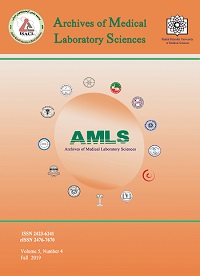Relationship between Delivery Type and Jaundice Severity among Newborns Referred to Hospital
Archives of Medical Laboratory Sciences,
Vol. 5 No. 4 (2019),
23 September 2019,
Page 8-13
https://doi.org/10.22037/amls.v5i4.32145
Background and Aim: Neonatal jaundice affects one of two newborns around the World and occurs when a baby has a high level of bilirubin in the blood. In recent decades, the cesarean section has increased, accompanied by higher neonatal jaundice risks compared with vaginal delivery. This study aimed to investigate the relationship between the jaundice severity and the delivery type and gender among newborns referred to a Qamar Bani Hashem Hospital in Khoy city (West Azerbaijan Province, Iran). Methods: In this cross-sectional study, we investigated randomly 309 newborns with asymptomatic jaundice, who referred to the hospital, from 2014 to 2018. The results of laboratory tests were recorded for all participating infants. Results: 49.19% of newborns with jaundice were born by cesarean section, and 49.19% were born by vaginal delivery. 141 (45.63%) of babies with jaundice were males, and 168 (54.37%) were females. Mean blood sugar (BS) (p=0.52), urea (p=0.48), creatinine(Cr) (p=0.69), Na (p=0.46), K (p=0.69), Ca (p=0.29), TB (p=0.58) and neonatal weight (p=0.14) within days 3 to 10 were not significantly different between vaginal delivery group and cesarean section group (p>0.05), while direct bilirubin showed significant variations (p<0.05). Mean serum direct bilirubin was 0.22±0.07 mg/dL in the normal vaginal delivery group and 0.25±0.09 mg/dL in the cesarean section group (p<0.05). Also, the level of K (P=0.04) was significantly higher in the male group compared to the female group. Conclusion: Based on our study, there is no significant relationship between the severity of jaundice and the type of delivery and gender in newborns.
*Corresponding Author: Haleh Barmaki; Email: Halebarmaki@gmail.com
Please cite this article as: Panji M, Behmard V, Varghaiyan Y, Sheikhalishahi ZS, Peyvasteh S, Seyedhashemi E, Zakeri M, Pooyanfar F, Barmaki H. Relationship between Delivery Type and Jaundice Severity among Newborns referred to Hospital. Arch Med Lab Sci. 2019;5(4):8-13. https://doi.org/10.22037/amls.v5i4.32145
